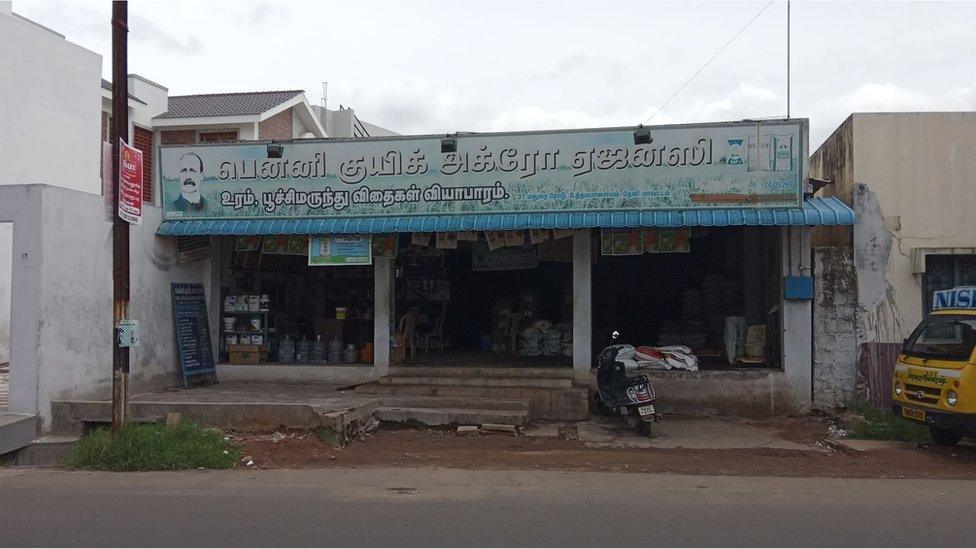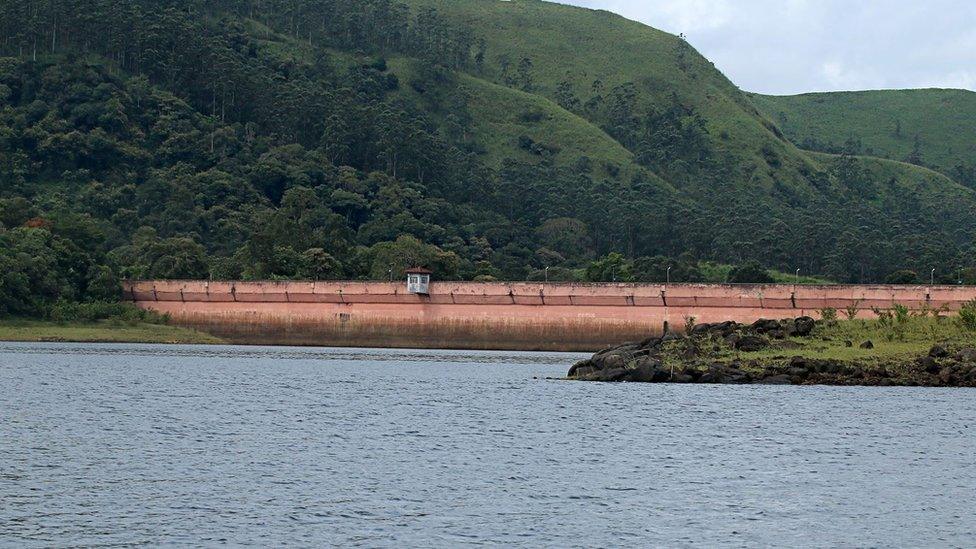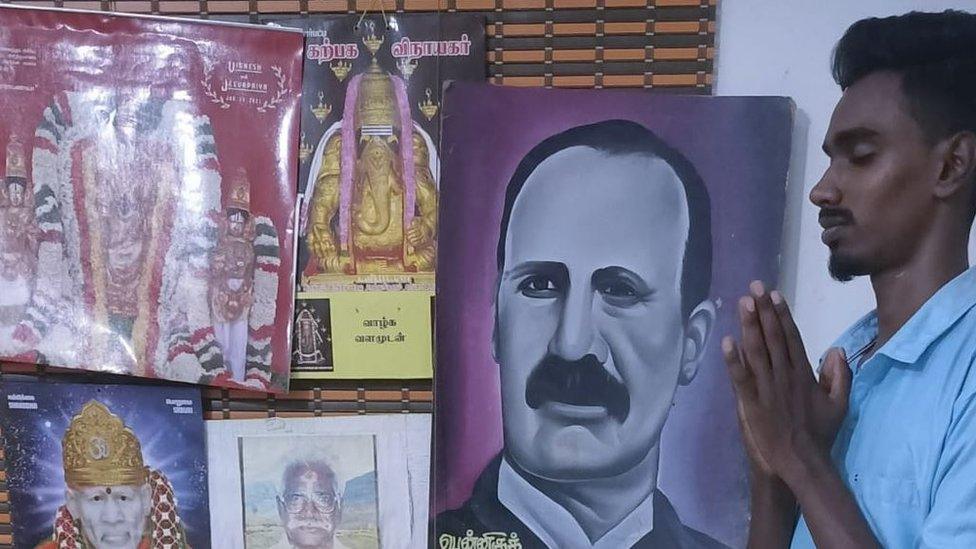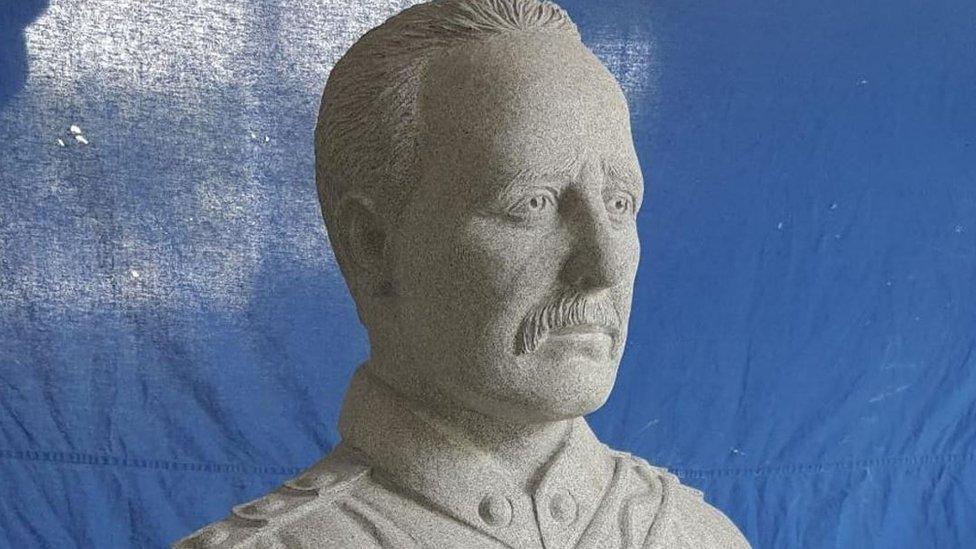John Pennycuick: The British-era colonel revered in Tamil Nadu
- Published

John Pennycuick is a revered figure in Tamil Nadu state
An Indian state has gifted the bust of a colonial-era British engineer to his hometown of Camberley in England.
The statue of Colonel John Pennycuick - donated by southern Tamil Nadu state - will be unveiled on 10 September at a public park in Camberley, 50km (31 miles) from London.
Pennycuick is a revered figure in Tamil Nadu for designing and building the Mullaperiyar dam, which provides water for drinking and irrigation to five districts in the state.
The 127-year-old dam has long been a source of tension between Tamil Nadu and neighbouring Kerala state, which has often called for its demolition.
But Pennycuick's legacy remains strong in Tamil Nadu, especially in the five districts which get water from Mullaperiyar. In one of them, Theni, photos of Pennycuick hang in shops, homes and government offices. Many baby boys are named Pennycuick while some have named their daughters Sarah after the engineer's mother.
"His work has not yet been fully recognised. Only people in our state [Tamil Nadu] knew about him," says Santhana Ibrahim, a London-based documentary maker who is the driving force behind the project to install the statue.
The making of Mullaperiyar
Pennycuick was born in the western Indian city of Pune in 1841. After receiving military training in London, he returned to India to join the British Indian army as an engineer.
Later, he joined the public works department of the erstwhile Madras Presidency, an administrative subdivision in the south of the country.

Many shops, homes and offices in Theni district have photos of Pennycuick
There, he worked on designing the Mullaperiyar dam, which would transfer water from the west-flowing Periyar river to the Vaigai river, which ran in the other direction.
In a paper titled The Diversion of the Periyar, written around 1897, Pennycuick says that the idea of building a dam had been mooted much earlier.
"The first recorded expression of it dates from the beginning of the present century, when surveys were made for the purpose of ascertaining how far the proposal was a practical one," he writes.
But the surveys, which were made "in a somewhat half-hearted manner", found the idea "impracticable", according to the paper.
That didn't dissuade Pennycuick, who set about getting his design approved. Construction began towards the end of 1888.
The chosen site "was in an uninhabited jungle, seven miles from the nearest point of a cart-road, 20 miles from the nearest cultivated land", he writes.
Construction materials were transported on boats and carts. Work had to be stopped for months in between because of jungle fever, and later, heavy rains and flooding.
Records show between 4,000 and 6,000 labourers worked on the project, which was completed in 1895.

An expert calls Mullaperiyar dam, located 881m above sea level, 'a feat of engineering'
"At the end of the 19th Century we had very few dams in south India," says K Sivasubramaniyan, a retired professor who has studied water management in Tamil Nadu for decades.
The Mullaperiyar dam, he says, was a "great engineering feat which helped end the water scarcity for people living in five districts in present-day Tamil Nadu".
'Like a god'
Desika Thiruvalan, 32, quit her job in a tech company a few years ago to oversee her family's farms. They own around 20 hectares of land in Theni district.
She says she is able to harvest two crops of rice every year, while her ancestors had to rely on unpredictable rains to irrigate their crops.
"Pennycuick is like a god to us. We are blessed to have plenty of water," she says, adding that before the dam, there were periodic famines and droughts in the region.

Desika Thiruvalan (right) says her family harvests two rice crops a year, thanks to the dam
Ms Thiruvalan's ancestor Peya Thevar was one of the locals who supplied food to the workers who built Mullaperiyar.
"When my husband went to a Hindu temple to perform a memorial service, he mentioned Pennycuick's name along with those of our ancestors," she says.
Over the years, many myths have developed around the engineer's legacy. In 2016, Pennycuick's great-grandson told Indian newspaper Mint that he had "no evidence" of a popular claim that the engineer used his own resources to build the dam.
While the engineer was a household name in parts of Tamil Nadu irrigated by the dam, elsewhere in the state not everyone had heard of him.
One namesake, now 20 years old, says as a boy he was bullied at school because of his name.
"I felt very awkward and was even angry with my dad for choosing it," recalls Pennycuick, a student who uses only one name.

Student Pennycuick has a photo of the colonial engineer along with the pantheon of Hindu gods
Pennycuick's father Gubendran had moved jobs from Madurai district, where the engineer is celebrated, to central Tamil Nadu where he was less well known. To help his son understand the significance of the name, Gubendran took him when he was 12 to see the dam, and a memorial to the engineer who had built it.
It was a life-changing moment for the young boy.
"There, I saw a statue of John Pennycuick and immediately realised how big his achievements were," he recalls. "Tears rolled down my cheeks."
Reviving a legacy
While the dam is in Kerala, Tamil Nadu operates it under a 999-year lease agreement to irrigate farmland on its side of the state border.
The dam has seen its share of controversies. In the late 1990s, Kerala expressed fears over its condition, triggering years of political and legal wrangling.
In 2014, India's Supreme Court ruled that the dam was safe, based on the findings of an expert panel, but its water storage level was reduced - and Kerala is still pursuing legal options.
"The dam helped irrigate about 340,000 acres [134,000 hectares] of land, but that has now halved," says Prof Sivasubramaniyan.
The controversy over the dam has only burnished Pennycuick's legacy in Tamil Nadu.
"It was only about 15 years ago that people started celebrating his birthday in public places," Ms Thiruvalan says.

The bust gifted by the Tamil Nadu government to the UK
His supporters, however, add that celebrating Pennycuick does not mean endorsing British colonialism.
"Pennycuick, due to his sheer determination, was able to build a dam which is still standing and providing water to us. We are just saying thanks to him," Ms Thiruvalan says.
After retirement, Pennycuick returned to England. He died in 1911 at Camberley, where he was buried. In 2019, a senior Tamil Nadu police official donated a bust of Pennycuick which was installed in the garden where the engineer was buried.
Mr Ibrahim, the film maker, hopes the new statue he's helped to organise will interest local residents in Tamil Nadu and its culture.
As for Pennycuick the student, he is content with his name and now has a dream.
"One day I will go and see the statue of Pennycuick in England."

Read more India stories from the BBC:

Related topics
- Published16 June 2022

- Published24 December 2021